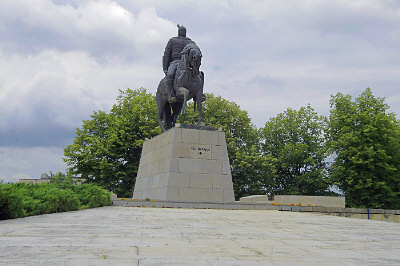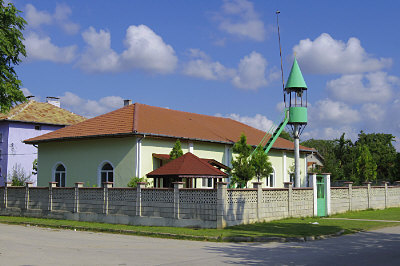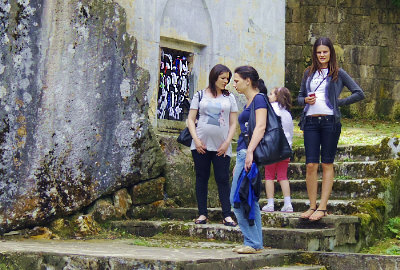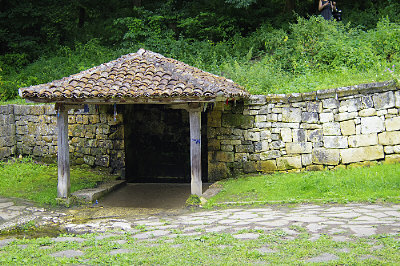|
Minoriteedid, lokaalsuse väljendused, pühapaigad. Ida-Bulgaaria.
Isperih.
|
Minorities, locality, sacred places. Eastern Bulgaria.
Isperih
|
Khaan Asparuh
Isperih (Türgi: Kemallar) on märkimisväärse türgi ja mustlasdominandiga linn. Koht on saanud oma nime Bulgaaria
khaan Asparuhi järgi, kelle slaavipärane nimi on Isperih.
Linnas on õigeusu kirikule lisaks mošee, mustlaslinnaosad on värvikad, kuid khaan Asperuhi kuju on kindlasti üks mõjukamaid ümbruskonnas.
|
Isperih (Turkish: Kemallar) Isperih was called Kemallar during the Ottoman rule of Bulgaria and was later renamed in honour of Bulgarian khan Asparuh, whose name in Slavic was Isperih.
The town has a mixed population of Bulgarians, Turks, and Romani with an Orthodox church and a mosque being present
|
|
Shvestari
UNESCO Maailmapärandi loetellu kuuluv traakia matusepaik avastati 1982 Sboryanovo arheoloogiliste välitööde käigus. 3. sajandi alguses eKr ehitatud hauakambri sisekujundus on ainulaadne oma naisekujude poolest. Võlvehitis kaeti valmimise järel tavakohaselt mullakihiga. Mälestusmärk kuulub traakia geta hõimule ja lähikonnas on kümneid samasuguseid hauakünkaid, sealt on leitud ridamisi aardeid. Nt 2012 suure aardeleiu jm põhjal on oletatud, et seal paiknes kuulus Helise linn.
|
Discovered and excavated in 1982 during excavations at the East Mound Necropolis of Sboryanovo (Ginina Mogila) - a tumulus of the early Hellenistic period, the Sveshtari tomb was built in the first quarter of the 3rd century BC. The tomb's construction reflects the fundamental structural principles of Tarcian cult buildings.
The tomb's architectural decor is considered to be unique, with polychrome half-human, half-plant caryatids and painted murals. The ten female figures carved in high relief on the walls of the central chamber and the decorations of the lunette in its vault are the only examples of this type found so far in the Thracian lands. It is an exceptional monument of the Getae, a Thracian people. In 2012, archaeologists uncovered a significant treasure near the village. It has been suggested that it is part of the site of the Getan city of Helis.
In the vicinity of the mausoleum, the remains of a large ancient city were found along with dozens of Getic mound tombs.
|
|
Lindid/Ribbons on the window
Demir Baba teke (Türgi: Demir Baba Tekkesi) on 16-nda sajandi alevi mausoleum (türbe) Sveshtari küla läheduses. Tekke on osa Sborjanovo ajaloolis-arheoloogilisest kaitsealast.
Mausoleum on arvatavasti Demir Baba, 16. sajandi alevi pühaku puhkepaik. Hauakamber ise on kohaliku liivakivist kaheksakandiline hoone. Demir Baba haud on siseruumis. Tellistest ja puidust sarkofaag on 3,74 meetrit pikk ja pea on paigutatud suunaga edelasse. Sarkofaag on kaetud kinkidega, mida jätkub ka akendele.
Mausoleum ehitati arvatavasti iidse traakia pühapiage peale (4 saj. eKr). Türbe ümber kerkis järk-järgult kultuskompleks (tekke). See hõlmas püha allika, mošee, ja puidust avaliku köögi (imaret). Tänaseni on säilinud mausoleum, allikas, eluhoone (ka pisimuuseumi ülesannetes), unikaalne ravikivi, kogu kompleks on ümbritsetud madala kivitaraga. Kahel pool treppi ja kaugel väljaspool tekke territooriumit on arvukalt ohvrilinte. Palverändurite (ka kristlaste) ja külastajate vool on pidev. Muide, tüüpiliselt Bulgaariale on tekke õues ka kohviautomaat. Alates 1970 on paik riikliku kaitse alla. Allika üheks nimeks on Bišbarmak - kuna Demir Baba olevat suure põua ajal maagilise toimega vee käega kaljust välja meelitanud.
|
Allikas/Spring
Demir Baba Tekke is a 16th-century Alevi mausoleum (türbe) near the village of Sveshtari. The mausoleum is thought to be the resting place of Demir Baba, a 16th-century Alevi saint. The tomb itself is a heptagonal building constructed out of local sandstone. It has a lower rectangular antechamber and is covered by a hemispherical dome 11 metres in height. Demir Baba's grave lies in the middle of the heptagonal inner premises. Constructed out of bricks and wood, the sarcophagus is 3.74 metres in length and is positioned with the saint's head pointing southwest. The sarcophagus is usually entirely covered by gifts.
A cult complex (tekke) gradually emerged around the türbe. This included a holy spring, a mosque, and a wooden public kitchen (imaret). The tekke features that have survived until today are the mausoleum, the holy spring (by the legend - Demir Baba put hand on the rock and healing water sprung out, so spring is called Besh Barmak), a residential building, healing stone and a low stone fence surrounding the complex.
Demir Baba Teke was proclaimed a monument of culture of local importance in 1970. There are many offereings in mausoleum but also on the both sides on stairway and far away from tekke.
There is saw people coming and going (pilgrims, visitors, patients). The places has also coffee Machine, typical to Bulgaria.
|







